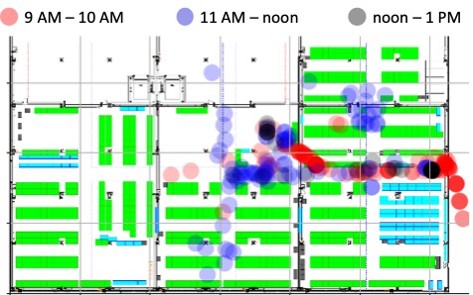As we consider re-opening broader segments of society in the wake of COVID-19, it is imperative that we implement comprehensive “Test and Trace” schemes, especially for industrial and commercial spaces, says Vikram Pavate, CEO of Locix Inc. While various testing methods are being scaled successfully, the current contact tracing process is manual, tedious and inefficient.
A number of wireless contact tracing approaches are being considered globally, including Apple and Google’s jointly announced Bluetooth-based solution. This solution uses Bluetooth to periodically capture an identifier of other Apple or Android smartphones in the vicinity, which can be later used to assess possible exposure if a positive patient advertises his/her COVID positive state.
This solution is noteworthy in its approach to consumer privacy. However, an inherent limitation of this or, any Bluetooth-based solution for that matter, is poor indoor positioning accuracy in commercial and industrial spaces, such as warehouses and distribution centres, factories, office buildings, hospitals, retail stores, and hotels. Bluetooth solutions are based on either RSSI (Relative Received Signal Strength Indication) or AOA (Angle of Arrival) measurements.
A key requirement of any proposed indoor wireless contact tracing solution should be robust indoor accuracy of better than six feet. However, these Bluetooth solutions have limited positioning accuracy (ten to one hundred feet) due to absorption, line of sight blockages and multi-path reflections in indoor spaces. These cumulative inefficiencies could result in significant levels of false positives in wireless-based contact tracing, potentially causing confusion, anxiety and disruption.
Additionally, Covid-19 spreads easily through community transmission where people contact objects and surfaces that have been touched previously by an infected person. Accurate indoor positioning and contact data is therefore essential to also identify objects and spaces of potential transmission for effective cleaning and disinfection.
Figure 1. Comparison of Wi-Fi-based indoor position accuracy in a commercial distribution centre. Leveraging advances in Wi-Fi and advanced analytics, indoor positioning accuracy of <3ft (approximately 1m) can be achieved.

Alternatively, the Wi-Fi -based contact tracing approaches are very promising for several reasons. First, as shown in Figure 1, improvements in advanced analytics and Wi-Fi quality enable Wi-Fi-based local positioning solutions to effectively demonstrate robust sub-three foot positioning accuracy in complex indoor environments.
This includes warehouses, distribution centres and commercial buildings. These advances allow Wi-Fi to overcome the inherent limitations of GPS and Bluetooth-based approaches to monitor real-time worker and asset position, movement, and occupancy at sub-meter (approx. 3 ft) levels, as shown in Figure 2.
Figure 2. Representative Wi-Fi-based worker contact tracing and exposure heatmap in a commercial distribution center. Each circle represents a spot where two workers passed each other within 6ft.

Contact and occupancy data can be tracked in real-time and on a historical basis and can be easily integrated with other databases (e.g., Public health) for additional contact tracing analytics. Additionally, all commercial and industrial spaces have existing Wi-Fi infrastructures. Most workers utilise Wi-Fi-enabled smart devices, including mobile phones, and battery-operated Wi-Fi-based trackers can be provided to workers who don’t have access to one. These devices connect to the secure networks in an opt-in scheme deployed and monitored by corporate IT groups.
This approach resolves required levels of worker consent, privacy and participation for robust contact tracing by encouraging workers to opt-in to securely monitored Wi-Fi networks. Lastly, Wi-Fi’s ubiquitous deployment and global standardisation allow corporation and organisations to build a globally meaningful contact tracing approaches for commercial and industrial spaces as workers are required to travel and physically engage with each other across the world.
In summary, Wi-Fi -enabled wireless contact tracing holds significant potential for effective and scalable contact tracing in indoor commercial and industrial spaces. It can be further enhanced with other complimentary consumer-level and public-health service initiatives. This will require co-operation between various key industry stake-holders as we jointly strive to re-open commercial and industrial environments safely and efficiently.
The author is Vikram Pavate, CEO of Locix Inc.
Comment on this article below or via Twitter: @IoTNow_OR @jcIoTnow










